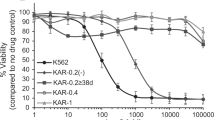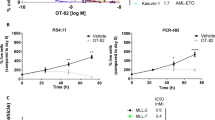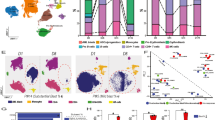Abstract
Patients with high-risk neuroblastoma (NB) initially respond to aggressive, alkylator-based therapy only to die from recurrent disease that is refractory to chemotherapy, including alkylating agents. We examined the ability of buthionine sulfoximine (BSO)-mediated glutathione (GSH) depletion to modulate melphalan (L-PAM) resistance in five NB cell lines established after progressive disease following myeloablative therapy (high-dose melphalan, carboplatin, etoposide and total body irradiation) supported by autologous hematopoietic stem cell transplant (AHSCT), and in 15 NB cell lines established at diagnosis or after non-myeloablative therapy (pre-AHSCT). Four of five post-AHSCT NB cell lines and 10 of 15 pre-AHSCT NB cell lines were sensitive to single agent BSO (LC90 <300 μM BSO), while two of five post-AHSCT lines and one of 15 pre-AHSCT lines showed high-level resistance to L-PAM (LC90>30 μM). Fixed ratio analysis demonstrated BSO/L-PAM synergy (combination index <1) for all five post-AHSCT and for all 15 pre-AHSCT cell lines tested. Multi-log cytotoxicity (often exceeding four logs of cell kill) was observed in post-AHSCT L-PAM-resistant cell lines (including p53 non-functional lines) only when clinically achievable concentrations of BSO were combined with myeloablative concentrations of L-PAM. We conclude that most neuroblastoma cell lines, including post-AHSCT NB cell lines that are highly resistant to myeloablative levels of L-PAM and lack p53 function, are sensitive to clinically achievable concentrations of L-PAM and BSO. However, some L-PAM-resistant NB cell lines (especially those lacking p53 function) require dose escalation of L-PAM to myeloablative concentrations in order to demonstrate significant synergistic cytotoxicity. Thus, optimal clinical application of BSO/L-PAM may require AHSCT.
This is a preview of subscription content, access via your institution
Access options
Subscribe to this journal
Receive 12 print issues and online access
$259.00 per year
only $21.58 per issue
Buy this article
- Purchase on Springer Link
- Instant access to full article PDF
Prices may be subject to local taxes which are calculated during checkout

Similar content being viewed by others
References
Reynolds CP, Seeger RC . Neuroblastoma In: Haskell CM (ed.) Cancer Treatment WB Saunders: Philadelphia 2000 pp 1214 1236
Seeger RC, Brodeur GM, Sather H et al. Association of multiple copies of the N-myc oncogene with rapid progression of neuroblastomas New Engl J Med 1985 313: 1111 1116
Haase GM, Perez C, Atkinson JB . Current aspects of biology, risk assessment, and treatment of neuroblastoma Semin Surg Oncol 1999 16: 91 104
Castleberry RP . Biology and treatment of neuroblastoma Pediatr Clin North Am 1997 4: 919 937
DuBois SG, Kalika Y, Lukens JN et al. Metastatic sites in stage IV and IVS neuroblastoma correlate with age, tumor biology, and survival J Pediatr Hematol Oncol 1999 21: 181 189
Seeger RC, Reynolds CP, Gallego R et al. Quantitative tumor cell content of bone marrow and blood as a predictor of outcome in stage IV neuroblastoma: a Children's Cancer Group Study J Clin Oncol 2000 18: 4067 4076
Matthay KK, Villablanca JG, Seeger RC et al. Treatment of high-risk neuroblastoma with intensive chemotherapy, radiotherapy, autologous bone marrow transplantation, and 13-cis-retinoic acid. Children's Cancer Group New Engl J Med 1999 341: 1165 1173
Keshelava N, Zuo JJ, Chen P et al. Loss of p53 function confers high-level multi-drug resistance in neuroblastoma cell lines Cancer Res 2001 61: 6185 6193
Tew KD, Houghton PJ, Houghton JA . Preclinical and clinical modulation of anticancer drugs In Preclinical and Clinical Modulation of Anticancer Drugs CRC Press: Boca Raton 1993 pp 13 17
Biaglow JE, Varnes ME, Clark EP et al. The role of thiols in cellular response to radiation and drugs Radiat Res 1983 95: 437 455
Meister A, Anderson ME . Glutathione Annu Rev Biochem 1983 52: 711 760
Russo A, DeGraff W, Friedman N et al. Selective modulation of glutathione levels in human normal versus tumor cells and subsequent differential response to chemotherapy drugs Cancer Res 1986 46: 2845 2848
Green JA, Vistica DT, Young RC et al. Potentiation of melphalan cytotoxicity in human ovarian cancer cell lines by glutathione depletion Cancer Res 1984 44: 5427 5431
Hamilton TC, Winker MA, Louie KG et al. Augmentation of adriamycin, melphalan, and cisplatin cytotoxicity in drug-resistant and -sensitive human ovarian carcinoma cell lines by buthionine sulfoximine mediated glutathione depletion Biochem Pharmacol 1985 34: 2583 2586
Siemann DW, Beyers KL . In vivo therapeutic potential of combination thiol depletion and alkylating chemotherapy Br J Cancer 1993 68: 1071 1079
Anderson CP, Tsai JM, Chan WW et al. Buthionine sulfoximine (BSO) is cytotoxic and enhances the activity of melphalan for human neuroblastoma cell lines Eur J Cancer 1997 33: 2016 2019
Anderson CP, Tsai JM, Meek WE et al. Depletion of glutathione (GSH) by buthionine sulfoximine (BSO) is cytotoxic for human neuroblastoma cell lines via apoptosis Exp Cell Res 1999 246: 183 192
Bailey HH, Mulcahy RT, Tutsch KD et al. Phase I clinical trial of intravenous L-buthionine sulfoximine and melphalan: an attempt at modulation of glutathione J Clin Oncol 1994 12: 194 205
Bailey HH, Ripple G, Tutsch KD et al. Phase I study of continuous-infusion L-S,R-buthionine sulfoximine with intravenous melphalan J Natl Cancer Inst 1997 89: 1789 1796
Anderson CP, Seeger RC, Matthay KK et al. Pilot study of buthionine sulfoximine (BSO) and melphalan (L-PAM) in children with recurrent neuroblastoma Proc Amer Soc Clin Oncol 1998 17: 531a
O'Dwyer PJ, Hamilton TC, Young RC et al. Depletion of glutathione in normal and malignant human cells in vivo by buthionine sulfoximine: clinical and biochemical results (see comments) J Natl Cancer Inst 1992 84: 264 267
Yao K, Godwin AK, Ozols RF et al. Variable baseline gamma-glutamylcysteine synthetase messenger RNA expression in peripheral mononuclear cells of cancer patients, and its induction by buthionine sulfoximine treatment Cancer Res 1993 53: 3662 3666
Keshelava N, Groshen S, Reynolds CP . Cross-resistance of topoisomerase I and II inhibitors in neuroblastoma cell lines Cancer Chemother Pharmacol 2000 45: 1 8
Reynolds CP, Tomayko MM, Donner L et al. Biological classification of cell lines derived from human extra-cranial neural tumors Prog Clin Biol Res 1988 271: 291 306
Anderson CP, Seeger RC, Satake N et al. Buthionine sulfoximine and myeloablative concentrations of melphalan overcome resistance in melphalan-resistant neuroblastoma cell line J Pediatr Hematol Oncol 2001 23: 500 505
Proffitt RT, Tran JV, Reynolds CP . A fluorescence digital image microscopy system for quantifying relative cell numbers in tissue culture plates Cytometry 1996 24: 204 213
Frgala T, Reynolds CP . Cytotoxic activity of deferoxamine and hydroxyurea for neuroblastoma in vitro Proc Amer Assoc Canc Res 1995 36: 303
Keshelava N, Yang YJ, Tsai JM et al. Drug resistance patterns in human neuroblastoma cell lines correlates with clinical therapy Eur J Cancer 1997 33: 2002 2006
Keshelava N, Seeger RC, Groshen S et al. Drug resistance patterns of human neuroblastoma cell lines derived from patients at different phases of therapy Cancer Res 1998 58: 5396 5405
Reynolds CP, Biedler JL, Spengler BA et al. Characterization of human neuroblastoma cell lines established before and after therapy J Natl Cancer Inst 1986 76: 375 387
Chou J, Chou T-C . Dose effect analysis with microcomputers. Dose Effect Analysis with Microcomputers Elsevier-Biosoft: Cambridge, UK 1988
Chou T-C, Talalay P . Quantitative analysis of dose–effect relationships: the combined effects of multiple drugs or enzyme inhibitors Adv Enzyme Regul 1984 22: 27 55
Chou TC, Motzer RJ, Tong Y et al. Computerized quantitation of synergism and antagonism of taxol, topotecan, and cisplatin against human teratocarcinoma cell growth: a rational approach to clinical protocol design J Natl Cancer Inst 1994 86: 1517 1524
Chou TC, Talaly P . A simple generalized equation for the analysis of multiple inhibitions of Michaelis–Menten kinetic systems J Biol Chem 1977 252: 6438 6442
Chou T-C, Rideout D, Chou J et al. Relationships between inhibition constants and fractional inhibitions in enzyme-catalyzed reactions with different numbers of reactants, different reaction mechanisms, and different types of mechanisms of inhibition Mol Pharmacol 1974 10: 235 247
Vandeputte C, Guizon I, Genestie-Denis I et al. A microtiter plate assay for total glutathione and glutathione disulfide contents in cultured/isolated cells: performance study of a new miniaturized protocol Cell Bio Toxicology 1994 10: 415 421
Anderson CP, Seeger RC, Matthay KK et al. Buthionine sulfoximine (BSO) and melphalan (L-Pam) is active against recurrent neuroblastoma Med Pediatr Oncol 1999 33: 158
Lazarus HM, Gray R, Ciobanu N et al. Phase I trial of high-dose melphalan, high-dose etoposide and autologous bone marrow re-infusion in solid tumors: an Eastern Cooperative Oncology Group (ECOG) study Bone Marrow Transplant 1994 14: 443 448
Pinguet F, Martel P, Fabbro M et al. Pharmacokinetics of high-dose intravenous melphalan in patients undergoing peripheral blood hematopoietic progenitor-cell transplantation Anticancer Res 1997 17: 605 611
Hersh MR, Ludden TM, Kuhn JG et al. Pharmacokinetics of high dose melphalan Invest New Drugs 1983 1: 331 334
Acknowledgements
Supported in part by the Neil Bogart Memorial Laboratories of the TJ Martell Foundation for Leukemia, Cancer, and AIDS Research, by National Cancer Institute Grant CA82830, by a National Research Service Award 2 T32 CA 09659 for training in basic research in oncology, and by NIH GCRC Grant 3MO1ROO43-38.
Author information
Authors and Affiliations
Corresponding author
Rights and permissions
About this article
Cite this article
Anderson, C., Reynolds, C. Synergistic cytotoxicity of buthionine sulfoximine (BSO) and intensive melphalan (L-PAM) for neuroblastoma cell lines established at relapse after myeloablative therapy. Bone Marrow Transplant 30, 135–140 (2002). https://doi.org/10.1038/sj.bmt.1703605
Received:
Accepted:
Published:
Issue Date:
DOI: https://doi.org/10.1038/sj.bmt.1703605
Keywords
This article is cited by
-
Natural products and the balancing act of autophagy-dependent/independent ferroptosis in cancer therapy
Naunyn-Schmiedeberg's Archives of Pharmacology (2023)
-
Induction and application of ferroptosis in cancer therapy
Cancer Cell International (2022)
-
Etoposide-resistance in a neuroblastoma model cell line is associated with 13q14.3 mono-allelic deletion and miRNA-15a/16-1 down-regulation
Scientific Reports (2018)
-
The glutathione synthesis inhibitor buthionine sulfoximine synergistically enhanced melphalan activity against preclinical models of multiple myeloma
Blood Cancer Journal (2014)
-
Biological therapy for pediatric malignancy: Current perspectives
The Indian Journal of Pediatrics (2008)



